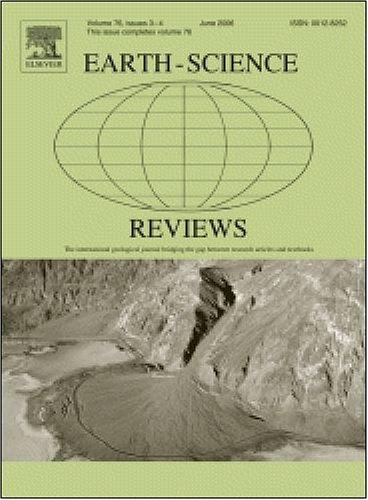Holocene extreme flood distribution patterns in the upper and middle Yellow River: A review based on slackwater deposits
IF 10.8
1区 地球科学
Q1 GEOSCIENCES, MULTIDISCIPLINARY
引用次数: 0
Abstract
Investigating the past occurrences of Yellow River floods provides essential insights into the river's natural variability and recurrent patterns over time. This historical context is indispensable for predicting and mitigating future flood events. However, comprehending the long-term variability of these extreme flood events faces challenges from the limited duration and sparse geographical distribution of gauging station records. Fortunately, flood slackwater deposits (SWDs) within the fluvial stratigraphy provide excellent records for reconstructing extreme floods beyond historical documents and modern observations. Here we scrutinize and synthesize the reported SWD records from the upper and middle Yellow River, and conduct a meta-analysis of these floods, in order to reconstruct the distribution patterns of extreme floods throughout the Holocene. 30 SWD sequences from 57 sites passed our rigorous data quality scrutiny, and subsequently total of 72 flood units (with different age-quality levels) were utilized to reconstruct the spatiotemporal distribution of Holocene extreme floods. Our results identified five extreme flood-rich periods, centered at 8500 yr BP, 6300–6100 yr BP, 4300–4000 yr BP, 3400–3000 yr BP, and 1800–1600 yr BP. The floods in these periods exhibit a significant increase in frequency and a shift in their spatial scale after ∼5000 yr BP, which are probably modulated by millennial-scale summer insolation, resulting in increased El Niño-Southern Oscillation activity and intensified latitudinal temperature gradient. Our comparison analysis between flood-rich periods and various climatic proxies suggests a centennial-scale ‘dry-cold’ climatic configuration during these periods. An anomalous low-latitude western North Pacific anticyclone, coupled with an anomalous mid-latitude cyclone-anticyclone pair, contribute to the convergence of water vapor from the western Pacific and Arctic region into northern China. This convergence led to extraordinary rainstorms and extreme floods in the upper and middle Yellow River, which significantly impact the human activity in the lower Yellow River. In addition, identifying Holocene extreme flood-rich periods and their climatic configurations offers new insights for predicting long-term extreme hydrological events in the region. Nonetheless, the uncertainty of our synthesis results owing to the limitation of currently available data should be considered and warrants verification in future studies.
黄河中上游全新世极端洪水分布模式:基于淡水沉积的述评
调查过去黄河洪水的发生情况,为了解河流的自然变化和周期性模式提供了重要的见解。这一历史背景对于预测和减轻未来的洪水事件是不可或缺的。然而,由于台站记录的持续时间有限和地理分布稀疏,对这些极端洪水事件的长期变化的理解面临挑战。幸运的是,河流地层中的洪水滞流沉积物(SWDs)为重建历史文献和现代观测之外的极端洪水提供了极好的记录。为了重建全新世极端洪水的时空分布格局,我们对黄河中上游地区已报道的SWD记录进行了梳理和综合,并对这些洪水进行了meta分析。我们对来自57个站点的30个SWD序列进行了严格的数据质量审查,随后利用72个不同年龄质量水平的洪水单元重建了全新世极端洪水的时空分布。结果表明,在8500年、6300-6100年、4300-4000年、3400-3000年和1800-1600年这5个极端富洪时期均有发生。在~ 5000年BP之后,这些时期的洪水呈现出频率显著增加和空间尺度的变化,这可能是由千年尺度的夏季光照调节的,导致El Niño-Southern振荡活动增加和纬向温度梯度加剧。我们对丰水期和各种气候指标的比较分析表明,在这些时期存在百年尺度的“干冷”气候配置。北太平洋西部低纬度异常反气旋与中纬度异常气旋-反气旋对共同作用,导致西太平洋和北极地区水汽辐合进入中国北部。这种辐合导致了黄河中上游地区的特大暴雨和特大洪水,对黄河下游地区的人类活动产生了重大影响。此外,确定全新世极端富洪期及其气候配置为预测该地区长期极端水文事件提供了新的见解。尽管如此,由于目前可用数据的限制,我们的综合结果的不确定性应该被考虑,并在未来的研究中得到验证。
本文章由计算机程序翻译,如有差异,请以英文原文为准。
求助全文
约1分钟内获得全文
求助全文
来源期刊

Earth-Science Reviews
地学-地球科学综合
CiteScore
21.70
自引率
5.80%
发文量
294
审稿时长
15.1 weeks
期刊介绍:
Covering a much wider field than the usual specialist journals, Earth Science Reviews publishes review articles dealing with all aspects of Earth Sciences, and is an important vehicle for allowing readers to see their particular interest related to the Earth Sciences as a whole.
 求助内容:
求助内容: 应助结果提醒方式:
应助结果提醒方式:


